Saint Andrew

The Saint's Andy Gray is a rarity in topflight football. He's a 'local boy' and has been at one club from the word go; except for what, on the playing side, would be called a loan deal with neighbouring AFC Bournemouth in 2005 when, for two years whilst still on the books at Southampton, he looked after the Dean Court pitch.
He's been a Saint's groundsman since 10th August 1998 - a date he readily recalls - when he joined the club as an apprentice under Dave Roberts. In those days, home was the Dell but, in 2001, the impressive new St Mary's Stadium took over and, by then, Andy was Dave's assistant. The Dean Court spell gave him a taste of being in charge of things. When Dave left the club in December 2007, Andy was recalled to be the St Mary's pitch number one man.
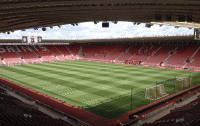
Pitch upkeep at the training centre and the stadium is entirely his to manage he tells me and, with this, comes responsibility and accountability, which he loves. "If I make a wrong decision, I'll stand up and be counted. That's the way it is for everyone here at Saints, , it's part of 'The Southampton Way'. I don't want someone above me telling me how I should maintain the pitches."
One of the club's stadium pitch trademarks has been its distinctive pitch mowing patterns, a creative skill Andy says he developed working with Dave Roberts. He quickly points out that it would only ever be done when the match result has no importance at the end of season. "If a team loses, it's either the ref's or the pitch's fault, so we have to make sure there's no room for criticism."
At the moment, there's no chance of fancy mowing at St Mary's with every match critical - and likely to be so right to the wire - in the quest for a Champions League place. In the previous five years, the club has either been at the top of a league trying to go up or at the bottom trying to stay up. Last season, getting a high Premier League place was possible right to the end of the season.
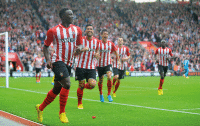
Pitch lights have been a massive contribution to the quality of the St Mary's playing surface and Andy has had them in his armoury for three years now. Television exposure has meant appearance is everything and, even on this murkiest of murky late November days, the grass looked like a bowling green, its 100 percent ryegrass sward as green and thick as a summer show lawn. Stadium Head Groundsman, Ian Lucas, and his assistant, Danny Silvestre, take huge credit for keeping St Mary's looking every inch an award winning pitch.

"They do listen to me, but we have to deliver. What do you need to get us the best pitch? I tell them, and it has to be right," he says firmly.
There are now six MU360 lighting rigs from SGL. The first three were purchased in November 2011 for use on the most shaded south end of the pitch. They did such a good job that they made the north end look bad by comparison, Andy tells me, so three more were purchased to achieve a uniform sward appearance. They are first switched on in mid-October and keep the 'sun shining' on the St Mary's grass until the middle of March. During matches, they are stored in a fenced-off part of the car park.
"They are a pain, but it's one I suffer gladly, because they do such a good job," says Andy. "Three hundred and sixty 1000-watt bulbs burning 24/7 means you can treat the pitch as if it's summer all year round. After a Saturday match, they are back burning by 7.00pm, and keep doing it until the Friday morning before the next Saturday match."
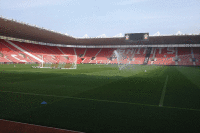
The stadium pitch is watered daily using a Hunter system with fourteen G995 sprinkler heads around the pitch and six I-90 turf risers in two sets of three within the pitch, these being installed in the summer break specifically with pre-match and half-time watering in mind. "Short and wet is what modern day players and coaches insist on," says Andy.
Premier League requirements for undersoil heating meant that, this year, there had to be more substantial close-season changes to the stadium pitch, however.
Northern Ireland-based contractors, Clive Richardson Ltd., were called in by Andy to reconstruct it, taking it back to gravel raft, removing all the rootzone and introducing the company's own fibre-sand mix. Sub-contractors, Top Turf Irrigation,the irrigation system with Ken Pryor doing the undersoil heating.
I asked him about why the club hasn't opted for a Desso surface? "Desso is fine and does a great job at multi-use stadia. St Mary's is not like that," he said. "It's a football venue, plain and simple, and what we have produces a fine surface all season without the expense of Desso installation. Until the need changes, I'll go with what makes best sense economically."
With half the season gone, and not a hint of wear and tear, you couldn't argue with that.
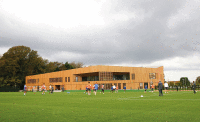
At the club's Staplewood training centre, eight miles from St Mary's, even in the foggy skies you can see the dockyard cranes piercing the horizon. There are currently four grass pitches and one 3G, all in use most days of the week. Security is very tight. Andy says it has only been that way this season. Surely it will be forever thus, now that the Saints do seem to be marching on. "With players worth £25 million, you can't take any chances," he says.
As we talk, there's a crew from MUTV milling around. How did they get the okay? The Saints Operations manager, John McWilliams, alerts Andy. "They are here because there's an under-21 match between the two clubs coming up," Andy tells me.
Life in the fast lane is getting to be routine. Andy keeps out of their way. He's more interested in telling me about how Staplewood is developing as a training complex.
Staplewood has been the training ground for the Saints since the early 1990s. It used to be just a single pitch us

Laid in summer 2013 were two Fibresand pitches either side of a grandstand, where the club's under-21 and under-18 sides train and play matches. Laid a year earlier was the first team pitch, also Fibresand, and now adjacent to the new Mark Liebherr Pavilion, named in honour of the late recent owner who saved the club from administration. The Pavilion was opened at the beginning of November and houses state-of-the-art indoor training facilities.
Staplewood's other existing grass pitch is natural soil based, but this is due to be up-graded to a Fibre pitch in March, for completion in May. The first three Fibresand pitches and the 3G were constructed successfully and satisfactorily by contractors Kestrel, Andy tells me.

The budget for the project, with the six new pitches, plus all the walkways and landscaping, is £2 million. It wouldn't mean much in the January transfer window but, as autumn turned to winter, it looked like another of Saint's home-grown products would soon be bearing fruit.
As Andy takes me around the complex, it is still very much a work in progress. The grass pitches had already been constructed and seeded and he was pleased that the late autumn weather was being so conducive to growing. Each day, he'd been counting

Graeme Mills is the Head Groundsman at Staplewood, heading up a team of five, soon to be seven when the complex is in full flow. He and Andy have a good working relationship with all of the club's coaching staff, right up to the new boss Ronald Koeman. There are daily discussions concerning pitch conditions. This particular day was a day-off for the first team squad - they'd just earned a draw at Villa Park - but they would be at Staplewood training five days a week come rain or shine.
Toro triples do the cutting work at Staplewood. A Verti-Drain and Toro ProCore tackle aeration needs both at Staplewood and at the stadium. There's plenty of other kit and Andy is especially keen on his TYM tractor - an inexpensive, yet very effective workhorse, he says. For the next couple of months, dew brushing, divoting and light topdressing of sand would be repeat dosing for all the grass surfaces.
Andy makes mention of some industry contacts he turns to for help and advice, including local sales rep, D
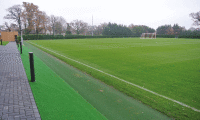
He also says there's genuinely pretty good camaraderie among Premier League groundsmen. "We are often in touch with each other, swapping tips and even getting a look at each other's pitches," he says. "When the Saints play Arsenal at the Emirates next, Steve Braddock is going to show us around the club's London Colney training set-up and, afterwards, Paul Ashcroft will show us the stadium."
He'd had to miss the opening ceremony of the Markus Liebherr Pavilion at the beginning of November. He was in Madrid after arranging a visit with Real's head groundsman, Paul Burgess, to view the Spanish club's training facilities and, afterwards, at the Bernabeu watching Liverpool play the team where Southampton's most famous playing son, Gareth Bale, now makes his living.
Rubbing shoulders with Spain's most successful club at pitchcare level is a measure of how highly the Saints are now regarded, and perhaps their ambition too. Current Spanish champions - Athletico, not Real - play in red and white stripes. An omen perhaps?
